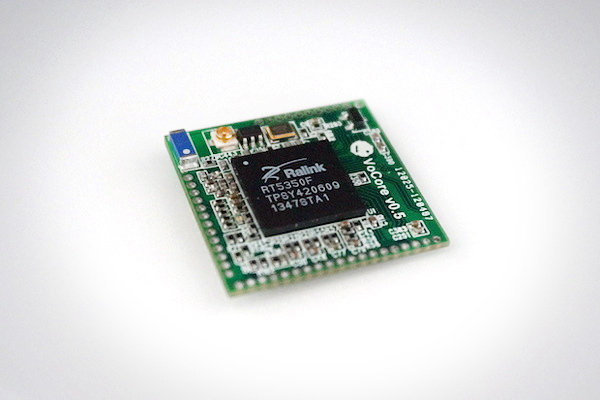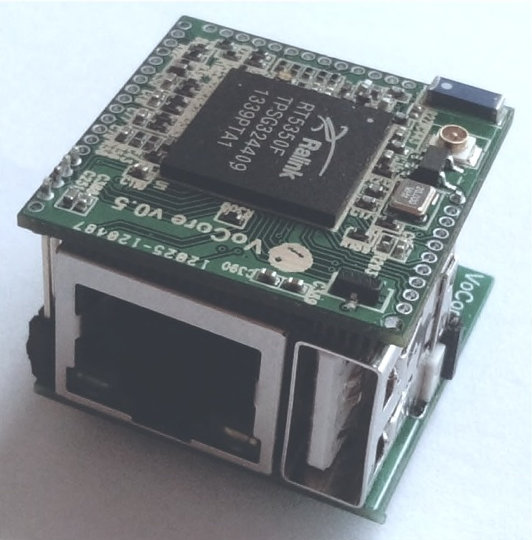There are already low cost Wi-Fi modules that can be used for the Internet of Things such as AsiaRF AWM002 and Hi-Link HLK-RM04. However, AsiaRF mainly caters to companies, and the Hi-Link module has a limited memory (16MB), which may or may not be an issue depending on your application. VoCore Wi-Fi module could prove to be an interesting option as it is the same $15 to $20 price range, runs OpenWRT with 32 MB RAM, will be open source hardware, and provides up to 20 GPIOs in a tiny (25x25mm) form factor.
 VoCore Wi-Fi module specifications:
VoCore Wi-Fi module specifications:
- SoC – Ralink/Mediatek RT5350 MIPS processor @ 360MHz with dual band 802.11n Wi-Fi with data Rate up to 150Mbps
- System Memory – 32 MB RAM
- Storage – 8MB SPI Flash (for firmware) / 16 MB on limited edition
- Available Signals (Via through holes):
- 10/100M Ethernet
- USB
- UART, I2C, SPI
- I2S, PCM
- JTAG
- Over 20 GPIOs
- Power Pins – 3.3V, 1.8V, GND
- Power Consumption – 200mA~210mA @ 5V (during ping)
- Dimensions – 25×25 mm
The developers envisions the device to be used for applications such as Wi-Fi to USB bridges (for printers, scanners…), robot remote controls, portable VPN routers, wireless speakers and more. He also promised to release all hardware design files including schematics, PCB layout, bill of materials, as well as source code for the boot loader and openWRT.

The project is currently on Indiegogo (fixed funding) where the developer aims to gather at least $6,000 to complete development, and go ahead with mass-production to lower the unit cost of the board. An early bird pledge will allow you to get the board for $15, after which it will go up to $20, and if you want the VoCore module with the Dock as shown above, you can pledge $40 to get a complete DIY kit (Soldering required) or $45 if you don’t feel like doing the assembly yourself. Shipping is free to the US and China, and an additional $3 anywhere else, with delivery scheduled for September and October depending on the perks.
The project’s progress can be followed on Vonger’s blog.
Thanks to Oliveira for the tip.

Jean-Luc started CNX Software in 2010 as a part-time endeavor, before quitting his job as a software engineering manager, and starting to write daily news, and reviews full time later in 2011.
Support CNX Software! Donate via cryptocurrencies, become a Patron on Patreon, or purchase goods on Amazon or Aliexpress




